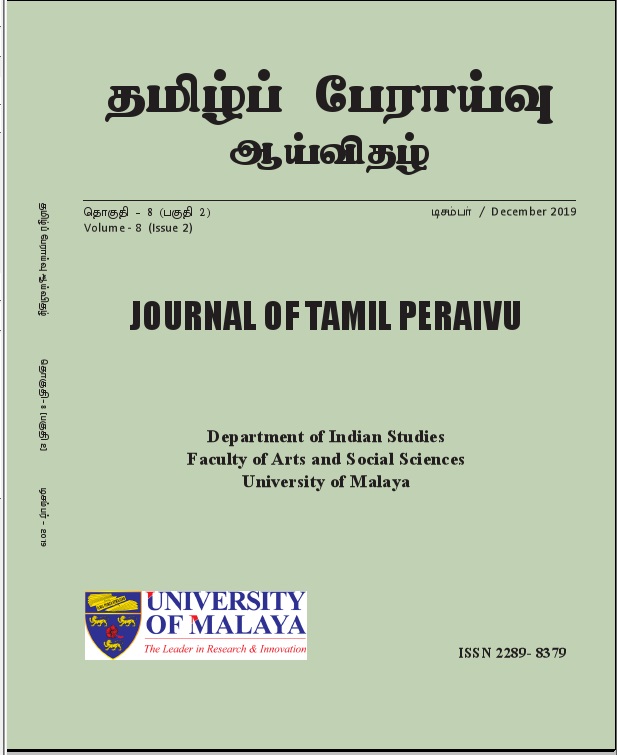மலாக்கா செட்டிகள் மலேசியத் தமிழர்கள்-பண்டிகைகளும் வழிபாட்டு முறைகளும் (Festivals and Religious Practices of Melaka Chetties among Malaysian Tamils)
Abstract
Melaka Chetties are the immigrants from South India who had visited Melaka for trade during the 15th century. In the process of their business dealings in Melaka they eventually married women ofMelaka, raised families and naturalized themselves as Melaka nationals. The descendants of these early traders from India became to be known as Melaka Chetties. They occupied many important positions during the Monarch’s rule in Melaka. On the other hand, many Indians from South India were also brought to Malaysia by the British later in the 18th and 19thcenturies. They were brought to work in various sectors such as Oil palm, Tea, Rubber, Sugarcane and Plantation estates. Apart from them there were others who were brought as Government servants, supervisors and were settled in Malaya. Furthermore, in order to involve in trading activities Tamilian settlers had settled in the towns and cities of Malaya. Those Indian immigrants from India were identified as Malaysian Indians after the independence in 1957. The early Indian immigrants since steppinginto Malaya have upheld the religious, beliefs, rituals and practices. In this manner of upholding they have sustained their religion and religious belief systems. Interestingly Melaka Chetties celebrate six major festivals such as BhogiParachu, Pongal, Karuparachu, Sivarathiri, Navarathiri, and Deepavali etc. On the other hand, Malaysian Indians celebrate Deepavali, Pongal and Thaipoosam. These celebrations of festivals help sustain and preserve their cultures while highlighting the uniqueness of the Malaysian Indian community.
Keywords: Chetty Melaka, Malaysian Indians, Culture, Festivals, Malaysia.
ஆய்வுச்சுருக்கம்
மலாக்கா செட்டிகள் 15-ஆம் நூற்றாண்டில் தமிழ் நாட்டிலிருந்து மலாக்காவிற்கு வாணிபம் மேற்கொள்ள வந்த தமிழ் வர்த்தகச் சமூகத்தினராவர். வர்த்தக நிமித்தமாக மலாக்காவிற்குப் வந்த இவர்கள் இங்குள்ள பெண்களை மணந்து பிள்ளைகள் பெற்று மலாக்கா நாட்டவர்களானார்கள். இவர்களுக்குப் பிறந்த பிள்ளைகளே (பெரனாக்கான்) மலாக்கா செட்டிகள் ஆகினர். மலாக்கா செட்டிகள் மலாக்கா மன்னர்கள் காலத்தில் அவர்களின் ஆட்சியில் பல முக்கியப் பொறுப்புகளை வகித்தவர்களாவர். அடுத்து, இன்று மலேசிய இந்தியர்கள் என அடையாளம் காணப்படும் மலேசியத் தமிழர்கள் 18-ஆம் நூற்றாண்டின் இறுதியிலும் 19-ஆம்நூற்றாண்டின் தொடக்கத்திலும் தமிழ் நாட்டிலிருந்து மலாயாவிற்கு பிரிட்டீசாரால் இரப்பர், செம்பனை, தேயிலை, கரும்பு, போன்ற தோட்டங்களில் வேலை செய்வதற்காகக் கொண்டுவரப்பட்ட மக்களாவர். இவர்களைத் தவிர்த்து அரசாங்க வேலையாட்களாகவும் பலர் மலாயாவில் குடியமர்த்தப்பட்டனர். மேலும், மலாயாவில் வாணிபம் மேற்கொள்ளவும் தமிழ் மக்கள் நகர்ப்புரங்களில் குடியேறினர். இவ்வாறு பிரிட்டீசாரின் காலத்தில் மலாயாவில் குடியேறிய தமிழ் மக்கள் பின்னர் மலாயா 1957-ஆம் ஆண்டு சுதந்திரம் அடைந்த பின்னர் மலேசியாவின் குடியுரிமை பெற்று மலேசிய இந்தியர்களாக அடையாளப்படுத்தப்பட்டனர். மலாயாவிற்கு குடிபெயர்ந்த காலம் தொட்டே இவர்கள் தங்களின் பண்பாட்டுப் பாரம்பரிய முறைகளையும் சமய, வழிபாட்டு முறைகளையும் நிலைநிறுத்யுள்ளனர். அந்த வகையில் இவ்விரு சமூகத்தினரும் பண்டிகைகளின் மூலமாகத் தங்களின் பண்பாடுகளையும் சமய நம்பிக்கைகளையும் பாதுகாத்துள்ளனர். பொதுவில் மலாக்கா செட்டிகள் போகிபரச்சு, பொங்கல், கனிப்பரச்சு, சிவராத்திரி, நவராத்திரி, தீபாவளி ஆகிய ஆறு பண்டிகைகளை முதன்மைப் பண்டிகைகளாகக் கொண்டாடுகின்றனர். மலேசியத் தமிழர்களோ இந்து சமயப் பண்டிகைகள் யாவையும் கொண்டாடினாலும் தீபாவளி, பொங்கல், தைபூசம் ஆகிய மூன்று பண்டிகைகளை மட்டும் மிகச் சிறப்பாகக் கொண்டாடுகின்றனர். இவை இவர்களின் பண்பாட்டை பாதுகாப்பதோடு இவற்றில் கலந்துள்ள உள்நாட்டுப் பழக்க வழக்கங்கள் இவர்களைத் தனித்துவம் மிக்கவர்களாகக் காட்டுகின்றது
கருச்சொற்கள்: மலாக்கா செட்டிகள், மலேசிய இந்தியர்கள், பண்பாடு, பண்டிகைகள், மலேசியா



